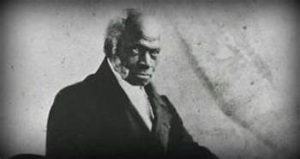
Pierre Toussaint
*Pierre Toussaint was born on this date in 1766. He was a Black Haitian businessman and philanthropist.
Toussaint was born a slave of the Bérard family in Saint-Domingue, the French western district of Hispaniola. He was born at the plantation of L’Artibonite, the island's wealthiest colony in antebellum France.
Little is known of his early life except that, like his mother and maternal grandmother, he spent his youth as a house slave on a plantation in the Artibonite Valley in central Haiti near the port of Saint Marc. In the library of the plantation owner, Pierre Bérard, young Toussaint discovered the works of classical French preachers such as Bossuet and Massillon. From his reading of these sermons, Toussaint developed his deep devotion to the Catholic faith.
1787, as political conditions in Haiti deteriorated, Jean-Jacques Bérard, who had inherited his father's estate, left Saint Domingue for New York, accompanied by his wife, Pierre Toussaint, and four other slaves. The following year, Bérard died suddenly in Saint Domingue on a fruitless visit to recover his property. His death left his widow, Marie Elizabeth Bérard, penniless in New York City. However, Toussaint supported her and himself from his earnings as a hairdresser, one of the few occupations open to blacks. Shortly before her death, on July 2, 1807, she and her second husband formally emancipated Toussaint in a ceremony at the French consulate in New York City.
Thereafter, Toussaint established a lucrative business as a hairdresser for upper-class women. He was from a period when most barbers were African Americans. His reputation enabled him to develop a large clientele. Some styles were so elaborate that wealthy women paid up to $1,000 to have their hair styled. His customers included the Hamilton's, Schuyler's, and Livingston's, the cream of New York society. "As a hairdresser for ladies, he was unrivaled," wrote one prominent socialite, Hannah Lee Sawyer. "He was the fashionable coiffeur of the day." Thanks to his income from this occupation, a frugal lifestyle, and wise investments, Toussaint prospered and bought his house at 144 Franklin Street. In 1811, he purchased the freedom of his sister Rosalie and another refugee from Saint Domingue, Mary Rose Juliette, whom he married in St. Peter's Church in 1811.
Although Toussaint's occupation as a hairdresser was financially rewarding, it was physically demanding. He regularly spent sixteen hours each day traveling throughout the city to the homes of his wealthy customers. The most convenient transportation would have been the extensive network of horse cars. Still, blacks were barred from using them, one example of the widespread racial discrimination he had to endure in antebellum New York. Moreover, as a Black in America in the predominantly Irish Catholic community and as a Haitian Catholic in the predominantly Protestant community, Toussaint belonged to a minuscule minority within each of these minority groups and was thus doubly disadvantaged. Culturally, he remained a Frenchman throughout his life, using French in his prayers, correspondence, and reading of Scripture.
Within the Catholic community, even during his lifetime, Toussaint enjoyed the reputation of an exceptionally devout and charitable person. Every day, he attended the 6:00 a.m. Mass in St. Peter's Church, where he was a pew holder for many years. He was also a benefactor of the Church of St. Vincent de Paul, New York's first French Catholic church, established in 1840. Perhaps his favorite charity was St. Patrick's Orphan Asylum, an institution he often visited. Although his marriage was childless, Toussaint and his wife made it a practice to take into their home destitute Black children and care for them until they could fend for themselves.
Toussaint played no role in the abolitionist movement, which is not surprising given the anti-Catholic sentiments of many abolitionists. Although he was among the few Blacks in New York City who could meet the property qualifications to vote, there is no indication that he ever cast a ballot. He was essentially a private peace-loving person who eschewed any political activity that might lead to violence, a legacy of his revolution experience in Saint Domingue. When someone asked him why he was not an abolitionist, he replied: "They have not seen blood flow as I have." He sought to bring relief to Blacks and whites through personal charitable efforts and generous financial contributions.
He died in New York City on June 30, 1853, and a funeral Mass was celebrated in St. Peter's Church. The pastor, Father William Quinn, eulogized him as a faithful parishioner for sixty-six years "who always had wise counsel for the rich and words of encouragement for the poor." In 1990, Cardinal John O'Connor of New York introduced the cause of Pierre Toussaint's canonization in Rome. In 1997, the Holy See declared him "Venerable," the first step in the lengthy process of securing official church recognition of him as a saint. His body was placed in the crypt beneath St. Patrick's Cathedral. He was a daily communicant at St. Peter Church in New York. It is said he did not miss any service in 66 years. Barclay Street in New York was renamed Pierre Toussaint Square to honor the hairdresser.
The National Black Catholic Congress
320 Cathedral Street
Baltimore, Maryland, 21201